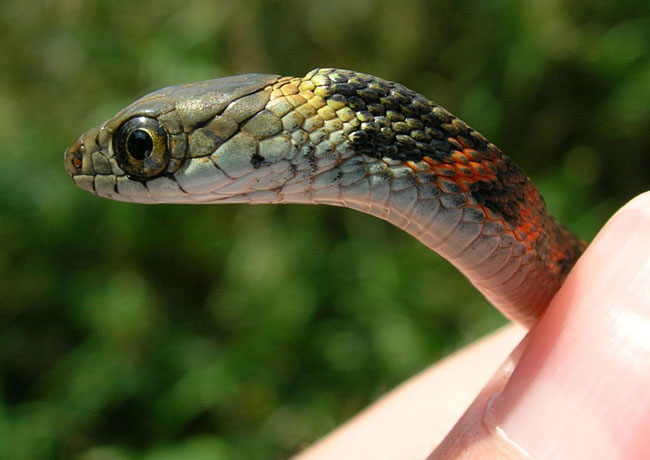Snake Eats Toxic Toad and Steals its Poison

The Asian snake Rhabdophis tigrinus is one tough customer. Not only can it swallow toxic toads and live to tell. It also uses the toad’s poison for its own defense, new research shows.
And rather than deploying the toxin, the snake uses it as the biological equivalent of waving a busted gun.
Where other snakes simply tolerate toxins secreted by their prey, “this is the only snake that’s truly known to use dietary toxins in its own defense,” said Deborah Hutchinson of Dominion University, lead author of the study.
The finding came when Hutchinson's colleague Akira Mori noticed that R. tigrinus showed some odd differences in behavior: Snakes that lived on Japanese islands with a plentiful toad population [image] would arch their neck and display their toxic neck glands [image] when a predator loomed nearby, but those on toad-free islands usually fled.
That led Mori to suspect that the snakes took the toxin from the toads they ate for supper instead of manufacturing the toxin themselves.
Toads secrete the toxin from their skin as a thick, white, viscous fluid that Hutchinson described as bitter and painful to predators that come into contact with it. (Because it is a cardiotoxin, in large quantity it can even stop a predator’s heart.)
Survival Advantage
Get the world’s most fascinating discoveries delivered straight to your inbox.
To test their hypothesis, the researchers collected both the "fight" snakes and the "flight" snakes from the islands in Japan. Analysis of the snakes' neck gland fluids revealed that snakes from toad-free islands lacked the toxic compounds. The team also found that the glands in all the snakes lacked the cell machinery needed for a toxin factory.
As a means of defense, the snake’s toxic glands are mostly all show—it doesn’t actually release the toxin. It only displays the glands.
Toxin-borrowing is common in invertebrates (Monarch butterflies takes up milkweed toxins, for example), but less so among vertebrates, Hutchinson said, though some frogs are known to take up toxins from ants and other insects they eat.
Toxic yolks
The researchers also experimented with snake hatchlings; when mothers lacked the toxins in their glands, so did their hatchlings.
“The hatchlings lacked these compounds—they only accumulated these toxins when they were fed toads,” Hutchinson told LiveScience.
Mother snakes that do eat the Japanese toads can pass the toxin along to their hatchlings through the egg yolk. In this way, mothers pass on a survival advantage to their young.
“That’s a way to arm their offspring right away,” Hutchinson said.
- Top 10 Deadliest Animals
- Images: Snakes of the World
- Flying Snakes: New Videos Reveal How They Do It
- Deadly Aim: Cobras Really Do Shoot for the Eyes
- Secret Weapons of Small Creatures
- All About Reptiles

Andrea Thompson is an associate editor at Scientific American, where she covers sustainability, energy and the environment. Prior to that, she was a senior writer covering climate science at Climate Central and a reporter and editor at Live Science, where she primarily covered Earth science and the environment. She holds a graduate degree in science health and environmental reporting from New York University, as well as a bachelor of science and and masters of science in atmospheric chemistry from the Georgia Institute of Technology.


